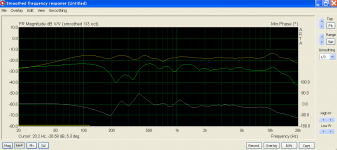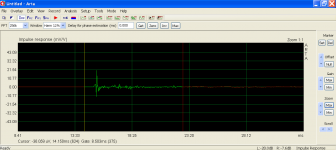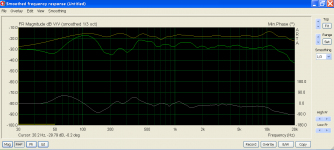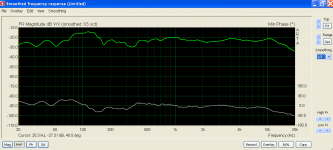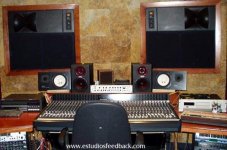I did make a bit a 4dB at 10kHZ rise in the response of my loudspeaker yellow line in living-room position. I show here a near field measurement on about 30-50cm (1or2 feet).
And the stereo response of both speakers I sit in a triangle of 3.5mtr (12feet)
Stereo response on ear hight measured green line and grey = minimum phase stereo on listening position.
What we see here I was right tuning high a bit louder and it seems that tole and others who resume him are right to on listening position I have also a decreasing slope. And the impulse response of the stereo measurement.


This one gated at 20msec

And the stereo response of both speakers I sit in a triangle of 3.5mtr (12feet)
Stereo response on ear hight measured green line and grey = minimum phase stereo on listening position.
What we see here I was right tuning high a bit louder and it seems that tole and others who resume him are right to on listening position I have also a decreasing slope. And the impulse response of the stereo measurement.
This one gated at 20msec
Attachments
Last edited:
After reading the L&V paper I have to say that I "liked" it because it directly tackles my favorite questions:
- Is constant directivity required ?
and if not
- "how much" controlled directivity is required/optimum ?
It was really the first time that I have read e.g. in an AES paper that flat power produces excess brightness.
Also, this paper is an additional source for the fact that increased reflected sound, if implemented properly, supports hiding the speakers, which is very important to me. If that means a certain level of excess brightness, I would trade delocalization for a non-flat on-axis FR right now.
Another conclusion of the paper is that dipoles with flat power are less prone to excess brightness compared to omnis (,which in this light is logical).
The dipole they used for the experiments was an ESL-63. It should be stated, though that L&V are very cautious about their conclusions. The paragraph starts like: "To the extend that one can legimately draw conclusions from these experiments we are led to deduce that...".
- Is constant directivity required ?
and if not
- "how much" controlled directivity is required/optimum ?
It was really the first time that I have read e.g. in an AES paper that flat power produces excess brightness.
Also, this paper is an additional source for the fact that increased reflected sound, if implemented properly, supports hiding the speakers, which is very important to me. If that means a certain level of excess brightness, I would trade delocalization for a non-flat on-axis FR right now.
Another conclusion of the paper is that dipoles with flat power are less prone to excess brightness compared to omnis (,which in this light is logical).
The dipole they used for the experiments was an ESL-63. It should be stated, though that L&V are very cautious about their conclusions. The paragraph starts like: "To the extend that one can legimately draw conclusions from these experiments we are led to deduce that...".
6.283 -
Apropos the L & V results, there are two ways of looking at this conclusion or perhaps as two separate issues.
Anyone who has attended to heartfelt urging in this forum for some time realizes that there seems to be a little disagreement that the natural house curve is more or less like the X-curve of theaters. I think that means that the "equal" or "humanly correct" neutral sound is not "mic flat" but it is X-curve flat. There really should be no one arguing that mic-flat is correct for music reproduction at home (or for that matter, in theaters). Dead issue, I'd say. Don't make speakers mic-flat.
Somewhat separately is this issue of how to achieve X-curve results. Remember, power response is a listener-centered or wholistic concept more than is direct SPL which is inherently anechoic. Therefore, power response naturally coincides with house curve outcomes and inevitably seems correct even if a house curve could be achieved in other ways.
My 2-cents.
Apropos the L & V results, there are two ways of looking at this conclusion or perhaps as two separate issues.
Anyone who has attended to heartfelt urging in this forum for some time realizes that there seems to be a little disagreement that the natural house curve is more or less like the X-curve of theaters. I think that means that the "equal" or "humanly correct" neutral sound is not "mic flat" but it is X-curve flat. There really should be no one arguing that mic-flat is correct for music reproduction at home (or for that matter, in theaters). Dead issue, I'd say. Don't make speakers mic-flat.
Somewhat separately is this issue of how to achieve X-curve results. Remember, power response is a listener-centered or wholistic concept more than is direct SPL which is inherently anechoic. Therefore, power response naturally coincides with house curve outcomes and inevitably seems correct even if a house curve could be achieved in other ways.
My 2-cents.
Your speakers are tuned to this curve bentoronto.
An externally hosted image should be here but it was not working when we last tested it.
6.283 -
Apropos the L & V results, there are two ways of looking at this conclusion or perhaps as two separate issues.
Anyone who has attended to heartfelt urging in this forum for some time realizes that there seems to be a little disagreement that the natural house curve is more or less like the X-curve of theaters. I think that means that the "equal" or "humanly correct" neutral sound is not "mic flat" but it is X-curve flat. There really should be no one arguing that mic-flat is correct for music reproduction at home (or for that matter, in theaters). Dead issue, I'd say. Don't make speakers mic-flat.
The natural house curve is similar to the X curve in notion but certainly not in degree. Remember that any of these RTA curves are steady state curves with more energy coming from the reverberent field than the direct sound. It is very possible to have flat direct sound and a rolled off reverberent field (not just possible but highly likely). The larger the room the greater the rolloff expected. In home listening rooms I have measured speakers that were flat anechoically and had about 2dB droop in the steady state curves at a typical distance. The X curve has far greater droop and also has some extra rolloff for historical reasons (to filter out film soundtrack noise, a defacto de-emphasis).
My belief: good speakers will measure with a slight droop in room measurements, but the same speaker should be flat on-axis in anechoic measurements.
David S.
Right, speaker dave. Various ways to accomplish an X-curve (or your own variant of it) as you point out. But as go-into-the-showroom specs, power curve will generally be more helpful, revealing, and/or truthful than direct energy curve.
The OB crowd inherently think in these whole-room terms, whatever one might think of that enclosure strategy in other respects.
Thanks, Helmuth. I think my room seems to produce an X-curve sound. Purely coincidentally since I've only recently started doing acoustic measurements which reveal that to me. Of course with my system and many others on this forum, I have enough controls to make an Elephant Curve with a waving trunk too!
The OB crowd inherently think in these whole-room terms, whatever one might think of that enclosure strategy in other respects.
Thanks, Helmuth. I think my room seems to produce an X-curve sound. Purely coincidentally since I've only recently started doing acoustic measurements which reveal that to me. Of course with my system and many others on this forum, I have enough controls to make an Elephant Curve with a waving trunk too!
-3dB at 30Hz looks ok to me 🙂I really don't like the bass end of that X-Curve..... Maybe just me.
Dan
I really don't like the bass end of that X-Curve..... Maybe just me.
Dan
Don't forget that the X curve is a cinema-only recommendation for the steady state response of a large cinema space. It evolved from earlier curves that were largely designed around the shortcomings of optical soundtracks. The previous theater curves were even more rolled off, so "extended" or X is a relative term.
If a modern theater uses the X curve they will also have large subwoofers with response well below 50.
Don't use the X curve for your home system! (or home theater, for that matter)
David S.
Yeah, a 10dB roll-off from 2K to 20K is going to sound pretty dull in a small to medium size space.
Don't worry Dave--I'm not about to use that curve. My -3 is around 15 right now. Audyssey actually had my system boosted radically after the first run through. Strange that it didn't the second run through after a more proper set up.
It would be cool to see an RT60 to go along with that X-Curve.
Dan
It would be cool to see an RT60 to go along with that X-Curve.
Dan
I don't know if it has been posted before.
Loudspeakers: Objective evaluations - Part 2: Measuring the essential properties of loudspeakers
Regards
George
Loudspeakers: Objective evaluations - Part 2: Measuring the essential properties of loudspeakers
Regards
George
I don't know if it has been posted before.
Loudspeakers: Objective evaluations - Part 2: Measuring the essential properties of loudspeakers
Regards
George
The un-named speaker modelled in figure 18.8 (page 3) is a JBL 4435 (1981-1996).
See also the Lansing History page at: 4430/35
Attachments
Last edited:
The un-named speaker modelled in figure 18.8 (page 3) is a JBL 4435 (1981-1996).
See also the Lansing History page at: 4430/35
Hi John,
I don't think the mentioned speaker is a 4435. We never worked on an active version while I was there. Also the description of the woofers "flanking" the CD horn isn't really the 4435 layout. Maybe it was an Everest product or a later studio monitor?
The Toole article is good, though, and has an interesting discussion of the Cinema X curve and the possibility that X farfield rolloff and flat direct response both coincide.
David S.
Hello David
Doesn't fit the Everest or K2's?? The last monitors were DMS-1 that did have a decicated DSP crossover, although the woofer layouts not quite right.
1995 DMS1
Like those 4411's
Rob🙂
Maybe it was an Everest product or a later studio monitor?
Doesn't fit the Everest or K2's?? The last monitors were DMS-1 that did have a decicated DSP crossover, although the woofer layouts not quite right.
1995 DMS1
Like those 4411's
Rob🙂
Hi John,
I don't think the mentioned speaker is a 4435. We never worked on an active version while I was there. Also the description of the woofers "flanking" the CD horn isn't really the 4435 layout. Maybe it was an Everest product or a later studio monitor?
The Toole article is good, though, and has an interesting discussion of the Cinema X curve and the possibility that X farfield rolloff and flat direct response both coincide.
David S.
Yes, I was thrown a bit by the description as well. However, the published graph in the paper closely resembles contemporary measured reviews of that particular system, in particular the nulls of the HF horn, which would not change that much from one measurement regimen to the next. There is also an active crossover commonly used with them in the field. That's how I came to the conclusion.
The DMS1 closely follows the physical description, but specifies a 14" LF driver , not a 15 (could just be a measuring difference, ie cone area vs O.D., but neodymium magnets on the DMS1 suggest a different driver than the 4435, but then again it raises the question as to why Toole referred to a 15). Perhaps a check of some measured reviews might give a clue to that possibility. I actually had the DMS1 in mind from the description but couldn't remember the model designation.
Admittedly, it's a guess. In those days, studios basically fell into a few standard designs and would usually have very specific monitors installed so that a given mix could be worked on worldwide. There are not really a lot of possible candidates given the description.
The speaker mentioned in the same graph (18.8 (b)) sounds like it might be a Klipsch Cornwall.
Last edited:
It's hard to tell what they are. JBL only had 2 monitors that were designed to be Bi Amp only those being the 4350/55 and the DMS-1. The 4430/35 used the 2234 with a 2421/2425/2426 and at about 15K-16K they all crashed. The speaker in question goes out to 20K so that doesn't really fit either?? Could be it's not a JBL??
I doubt that the speaker in B is a Cornwall. The upper crossover is around 10K to high and the directivity is too smooth for no CD exponential horns sensitivity is also too low. I would guess it's closer to a K2 9800 who knows??
K2-S9800
Rob🙂
I doubt that the speaker in B is a Cornwall. The upper crossover is around 10K to high and the directivity is too smooth for no CD exponential horns sensitivity is also too low. I would guess it's closer to a K2 9800 who knows??
K2-S9800
Rob🙂
I thought the DMS-1 was a good guess but the woofer size description is a bit off. By the way, the 14" unit is a descendent of the original LE14. It was "nearly the cone size of a 15 in a chassis the size of a 12". It started the LE tradition of thin surround, minimal chassis overlap and the square basket look. A very interesting woofer especially with the long gap, short voice coil configuration. It is a very different woofer than the 2234 round 15" style.
David S.
David S.
...
I doubt that the speaker in B is a Cornwall. The upper crossover is around 10K to high and the directivity is too smooth for no CD exponential horns sensitivity is also too low. I would guess it's closer to a K2 9800 who knows??
K2-S9800
Rob🙂
The Cornwall's sensitivity is lower than the all-horn Klipsch speakers, Paul says -6dB which would make it about right. Crossover was 600 and 6000 Hz @ 6dB/oct (original) or 18 dB/oct (revised, early 70's; the Cornwall x-oer was changed again in 1981 but not changed in slope or frequency). I see a large null at 10K on the chart but there are also nulls at 600 and 6K.
Anyway, I don't think any of us are really nailing it so I'll let it rest. It was a fun exercise, though.
Last edited:
- Status
- Not open for further replies.
- Home
- Loudspeakers
- Multi-Way
- We know that Frequency Response isn't the end all be all... so what else is there?
